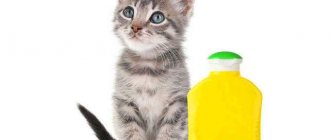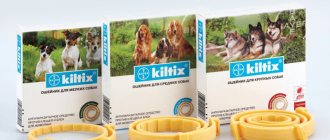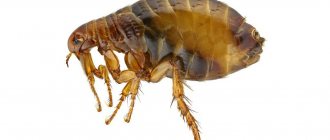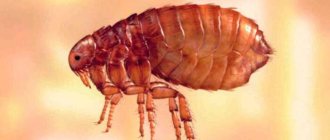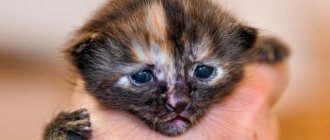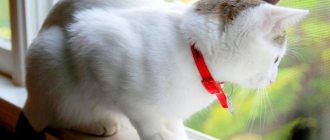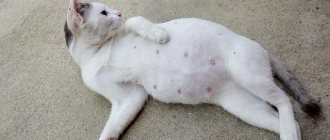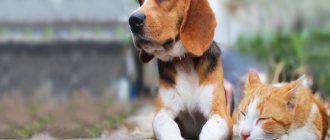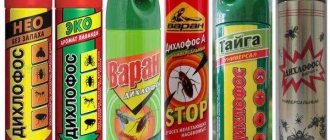Currently, pet stores have a large selection of products for getting rid of insects from adult cats. But how to remove fleas from a kitten? This task is not easy, since it is not recommended to treat babies with traditional medications intended for adult animals. The kitten is constantly licked by the mother, and the medicine, entering the cat’s esophagus, then ends up in her milk, which can cause much more harm to the baby than fleas.
In this regard, there are differences in the methods of removing fleas from newborn kittens and those whose age is 1 month or more.
Flea drops for kittens
Flea remedies for kittens must be selected with special care, because many of them can have an extremely negative effect not only on parasites, but also on the pets themselves.
When choosing flea drops for kittens, you need to focus on the age of the kids. In the first months of life, kittens still have too weak an immune system. Drops, which contain highly toxic substances, can cause much more harm to a pet’s health than fleas, and even lead to its death.
That is why it is advisable to use such drugs to treat a pet only after it reaches 2–3 months of age.
If the baby is breastfed, before flea treatment you need to assess the degree of its infestation. Cats lick their kittens, and this helps them to some extent get rid of parasites. However, it is precisely because of regular licking that all substances applied to the baby’s fur will inevitably end up first in the cat’s gastrointestinal tract, and then through the milk and to the kitten.
For this reason, if the number of parasites is small, it is better to rid the kitten of fleas when breastfeeding is completed.
Important! Owners should remember that it is strictly prohibited to remove fleas using insecticidal preparations for sick and weakened kittens.
Disinsection of a lactating cat
If you do not expel the insects from the cat, they will again pass on to the children. Of course, finding fleas on a kitten means that there are fleas on the mother as well. You cannot wet the cat with conventional means - Stomazan or its analogues; the active components will be excreted in the milk or licked by the baby from the mother. In this regard, Stronghold drops are relatively safe; the active ingredient, Selamectin, is not excreted in milk. The drug is sold packaged in pipettes, the contents of which are applied between the shoulder blades.
The cat carries kittens, grabbing the withers
The insecticide is allowed to dry. This takes two hours. After this, the poison becomes insoluble in the kitten’s saliva. The trouble is that all the drops do not act simultaneously. It takes a day for the fleas to leave the cat or die. The insects still have a chance to jump onto the baby. Therefore, it is necessary to observe the kitten for a day or two, and if insects are found again, comb them out.
Drops Strongold
The kittens themselves can be treated with this product after weaning and reaching six weeks of age.
Where can a kitten get fleas?
Unfortunately, fleas appear on kittens quite often. And not only among street kids, but also among domestic kittens.
Female fleas throw out fertilized eggs over fairly long distances as they move. They roll off the cat's fur and accumulate in the corners of the apartment. Subsequently, larvae emerge from the eggs, and then pupae, which are ready to wait for their prey for months, even under unfavorable conditions.
There are several ways kittens can become infected with fleas:
- Other animals. Babies can become infected with external parasites not only from their mother, but also from other pets who live in the house and have free access to the outside.
- Human. Fleas in newborn kittens can appear after direct contact with the owner's outdoor clothing or shoes.
- Rodents. Sometimes kittens pick up fleas after hunting mice or other rodents.
- Street. If kids have the opportunity to go outside, they are almost 100% likely to become infected with fleas.
Fleas cause serious damage to the health of animals. That is why owners need to identify symptoms of infection as soon as possible and take measures to rid the kitten of fleas.
Folk remedies
In folk practice, a whole arsenal of means has accumulated for killing fleas in kittens. Unlike medications, they are based on herbs that do not harm the health of cats and kittens. These include, for example:
- Sagebrush. A tablespoon of dry leaves is poured with boiling water (500 ml) and boiled for 15 minutes. The animal is washed with the resulting decoction. A mother cat, even after licking her offspring, will not be poisoned. You can simply put fresh wormwood grass in the kittens’ house.
- Tansy. A decoction of tansy is made in the same way as wormwood. Used to treat kitten fur.
- Garlic. A head of garlic is passed through a press, poured with a liter of warm water and left for 12 hours. The resulting infusion is used to treat the kitten’s skin, especially in places where insects are most concentrated: in the armpits, on the tummy, in the groin.
- Geranium. 2 tablespoons of leaves are poured into 500 ml of water and boiled for 20 minutes. Small kittens are bathed in the broth.
- Lemon. Grind a small lemon, add a glass of water and leave for a day. Then the kitten is sprayed with the prepared infusion from a spray bottle.
- Essential oils. Oils of mint, cedar, lemon, geranium, rosemary and lavender have proven themselves to be effective against fleas. 2-3 drops of oil are diluted in 2-3 glasses of water and sprayed on the kittens.
You can get rid of fleas in another proven way: fill the kitten’s bed with pine sawdust or fresh shavings.
Video: personal experience of using folk remedies against fleas
How to detect parasites
Fleas in kittens can only be detected with careful examination or if there are too many parasites, but outwardly the baby may look quite healthy.
Characteristic signs of a kitten being infected with fleas:
- The pet often itches, and he begins to do it very sharply.
- Flea excrement in the form of small black particles or flea eggs can be found on the neck, ears and stomach.
- Non-healing wounds and scratches appear on the animal’s skin.
- The baby is inactive, weak, eats poorly, and loses weight.
- Your pet's fur is falling out.
- The pet sleeps very restlessly.
Important! In particularly advanced conditions, the baby may develop dermatitis, dermatophiliasis and other ulcerative skin lesions.
Symptoms of appearance
- itching, loss of appetite;
- weakness, lethargy . Usually these symptoms appear due to large blood loss due to bites;
- redness of the skin, wounds, ulcers . After the bite, an infection occurred and an inflammatory process began;
- allergic reaction.
If at least one of the listed symptoms is present, you should immediately carefully examine the baby. You can do this yourself by spreading the fur on his back or belly. The presence of small white and black grains on the body (eggs and excrement of parasites) will immediately confirm your guesses.
How to remove fleas from small kittens
Of course, every owner wants to remove fleas from a kitten at home as efficiently and safely as possible.
The method of combating parasites depends on the age of the pet: the younger it is, the more limited the range of anti-flea drugs approved for use becomes. For your small pet, you can choose one of the following methods of getting rid of these insects:
- mechanical cleaning by combing;
- bathing with antiparasitic shampoo;
- use of gentle insecticidal preparations;
- the use of various folk remedies.
From 2 days of age
Fipronil Spray is the only drug that can be used to remove fleas from a nursing cat and newborn kittens older than 2 days, as well as from pregnant individuals. However, at the time of applying the spray the animal must be completely healthy.
This preparation must be sprayed over the surface of the animal’s fur (in the direction of its growth) from a distance of 10–20 cm so that it is saturated all the way to the skin. Long-haired individuals will probably need to be combed and then repeated.
The drug should be applied to the face with a rubber glove and gently rubbed into the fur. Then you need to wait for the spray to dry naturally. At this time, the owners will have to make sure that the baby does not lick the drug, since if ingested, the drug can cause increased salivation, vomiting and difficulty breathing.
When treating a pet with this drug, you must follow the dosage: 2–4 presses on the spray bottle per 1 kg of pet’s weight for bottles of 250 and 500 ml or 6–12 presses for bottles of 100 ml.
This drug protects the animal from fleas for a period of 1 to 3 months. If the kitten is often outdoors, the treatment should be repeated every 4 weeks.
From 7 days of age
Fiprist Spray is another drug that can be used to treat kittens against fleas at home if they are one week old.
The product should be sprayed onto the animal’s fur (against hair growth) from a distance of 10–20 cm. To prevent the solution from being licked off before it dries completely, it is recommended to put a special collar on the pet.
It is also necessary to ensure that the drug does not get into the eyes when spraying the chest and ears. Treatment should be carried out outdoors or indoors with open windows. For 2 days before and after using the drug, you should not bathe the baby, stroke him or allow contact with children.
When treating your baby with this product, you must strictly adhere to the dosage: 3–6 ml of spray per 1 kg of weight. In this case, 1 injection for 100 ml bottles is 0.5 ml of the drug dose and 1.5 ml of the dose for 250 ml bottles. In case of an overdose, your pet may experience increased salivation, trembling and vomiting.
This drug destroys not only adult parasites, but also their offspring at all stages of development. The protective effect of the drug lasts approximately 40 days after treatment.
From 6 weeks of age
The BEAFAR SOS flea collar for kittens is designed specifically for babies who have reached the age of 6 weeks. It is practically odorless, safe for kittens and equipped with a special quick-release clasp.
The active ingredient in this collar is tetrachlorvinphos. It does not penetrate the animal’s circulatory system, but spreads through the skin fat. The substance has a negative effect on external parasites even before they bite your pet, which helps avoid the appearance of dermatitis and other skin diseases.
Effects on external parasites begin 5 days after the collar is put on. When worn continuously, BEAFAR SOS provides the kitten with protection against fleas and lice for 8 months, and against scabies and ixodid mites for 4.
Important! Water procedures while wearing the collar do not weaken its effect on parasites.
From 8 weeks of age
Bars Forte drops for kittens are effective against fleas, lice and lice at all stages of their development. This product is available in the form of 1 ml dropper pipettes. The drug contains fipronil. It blocks receptors and leads to paralysis and death of adults, and also regulates the growth of parasites (disturbs the processes of molting and pupation of fleas).
This product is approved for use by healthy kittens over 2 months old. To rid your pet of fleas, you need to treat it with the drug in places that are inaccessible for licking.
The dosage should be as follows: 1 dropper pipette per 1 animal weighing up to 1 kg. If the pet weighs more than 1 kg, then the volume of the drug must be doubled.
For 24 hours after applying the drops, the baby should not be stroked or allowed to come into contact with children.
These drops provide your pet with flea protection for 3 months. Repeated treatment cannot be carried out more than once a month.
From 10 weeks of age
Insecto-acaricidal drops for kittens Dana are used to combat adult and offspring fleas, lice and ticks in kittens that have reached the age of 10 weeks. The drug is available in the form of 0.5 ml pipettes. The active ingredient is diazinon.
It manifests its effect 12–24 hours after application and accumulates in the skin, sebaceous glands and hair follicles.
To treat a kitten against fleas, it is necessary to apply the drug in places inaccessible to licking in the following dosage: 1 pipette for animals weighing less than 1 kg, 2 pipettes for kittens weighing more than 1 kg.
The kitten should not be bathed for 3 days before and after using the drops. The treated pet must not be stroked or allowed near children for 24 hours.
The duration of the protective anti-flea effect of the drug is approximately 2 months. Repeated treatment should be carried out according to indications, but not more than once a month.
Danger of infection
Uninvited residents on the pet’s body not only cause discomfort and the risk of spreading throughout the home, but also pose a serious threat to the health of the mustachioed friend.
How dangerous are fleas on a cat?
The main danger of fleas in cats is as follows:
- Bloodsuckers carry various infectious diseases. For example, infected cats have an increased risk of developing worms.
- Bites contribute to the formation of wounds, hair loss, deterioration of its structure and appearance.
- A large number of fleas and prolonged infestation cause the development of anemia, and in weakened kittens it can be fatal.
- The presence of wounds and abscesses provides access to allergens and the development of skin dermatitis.
The disease is especially difficult in elderly and weakened animals, in small kittens with a low immune system and in nursing mother cats.
Eliminating the consequences of flea bites
If there are still lesions on your cat's skin after flea removal, they need to be treated. Sores or scabs are smeared with healing ointments, which the veterinarian will recommend. To prevent the pet from scratching itself and licking the medicine, a collar is put on it.
In case of allergies, the animal is given antihistamines. The doctor will prescribe the medicine and dosage. To reduce itching, a special ointment is applied locally.
If fleas have caused helminthiasis in a cat, it is necessary to deworm it and other pets living in the same area. To do this, special anthelmintics are given twice, with an interval of 1-2 weeks. The dose calculation is based on the weight of the animal. Before use, you must carefully read the instructions for the drug.
Harm to humans
Flea infestation is also dangerous for people, because it can cause skin rashes, dermatitis and infection of the entire body. Parasites carry unpleasant diseases, the most dangerous of which are encephalitis and salmonellosis.
Fortunately, serious diseases are rarely transmitted through flea bites, but the very fact of insects living in the house becomes a big nuisance. They jump on surfaces and can bite a person's legs. The only measure is disinfestation in an apartment or house, which is carried out simultaneously with treating the animal for fleas.
How to remove fleas from kittens from 2 months of age
The list of drugs that can be used to treat fleas when a kitten reaches 2 months of age becomes more diverse. In most cases, to kill external parasites in older cats, you can use the same medications as for adult cats.
However, before the first use, it is advisable to use the product in a small volume in order to assess the reaction of the baby’s body.
Drops
Flea drops are considered one of the most convenient methods of killing parasites in kittens. They help get rid of not only fleas, but also lice and ticks. In addition, the drops provide babies with protection from re-infection for 1 month.
To treat your pet, you need to spread the hair at the withers and apply the drug to the skin in a dosage that corresponds to the age or weight of the kitten.
It is recommended to treat flea drops only in completely healthy babies and kittens who are no longer breastfed, since these drugs are particularly toxic. Otherwise, when licking, toxic substances will enter the cat’s body, and from there into the milk.
According to most veterinarians, the following drops for fleas in kittens are considered the most effective:
- Advantage;
- Bloch Netmax;
- Hartz;
- Stronghold.
Sprays
Sprays are one of the fastest ways to kill fleas on kittens. With the help of such drugs you can kill fleas and their offspring in just a few hours.
Anti-flea sprays are sprayed directly onto the baby’s fur (in the direction of its growth or against it, depending on the manufacturer’s recommendations) in strict accordance with the dosage specified in the instructions. There is no need to wash off such preparations.
The substances that make up flea sprays are particularly toxic. That is why such drugs should only be used for completely healthy kittens that are already feeding on their own. For several hours after applying the product, you should not allow the kitten to lick itself, but it is better to put a protective collar on it and wait for the spray to dry.
It is also recommended to spray all places in the house where the pet lives, and then thoroughly vacuum everything and ventilate the room.
The most effective sprays against fleas in kittens are from the following manufacturers:
- Hartz;
- Frontline;
- BlochNet.
Shampoos
A special anti-flea shampoo for kittens is the safest, but most labor-intensive method of killing parasites in small pets. Many shampoos are allowed to be used from one month onwards, because they are made on the basis of plant extracts.
You can wash your kitten with shampoo as follows:
- First, it is advisable to trim your pet’s nails to protect your hands from deep scratches.
- Fill a basin with warm water. Its temperature should be 38–42 °C.
- Gently wet your pet's fur.
- Apply shampoo diluted in a small amount of water to the baby’s body and paws, lather and hold for 5–7 minutes.
- Rinse the product thoroughly under warm running water so that the kitten does not get poisoned when licking it.
- Wrap your pet in a warm towel.
- Once dry, comb out fleas and their eggs.
Important! During application, be careful not to get the shampoo into the kitten's mouth, nose, or eyes.
To achieve an effective result, the baby must be bathed with shampoo 2-3 more times with an interval of 10 days until the fleas completely disappear.
The following anti-flea shampoos are currently most popular:
- Phytoelite;
- Kiss;
- RolfClub.
Collars
Flea collars are the easiest way to control fleas on kittens. You just need to take it out of the package, put it on your pet and fix it according to the size of his neck.
It is recommended to use a collar if there are several pets in the house, and one of them has fleas. It is also advisable to put a collar on the kitten if the mother has parasites. Such flea remedies are more likely to prevent re-infection, but they are unlikely to be able to completely destroy the insects. For maximum effectiveness, it is recommended to use the collar together with spray or shampoo.
Some kittens experience discomfort from an uncomfortable collar and constantly try to remove it, thereby damaging their skin. Sometimes the substances that make up this flea remedy irritate the delicate skin of babies or cause allergy attacks.
The duration of the protective effect of the collar depends on its price: more expensive options not only “work” longer, but also have a waterproof effect.
Veterinarians consider collars from the following manufacturers to be the most effective:
- Beaphar;
- Foresto;
- Bolfo.
Powder
To destroy external parasites in kittens, it is allowed to use a special anti-flea powder, which is approved for use even by babies a few days old.
The powder must be thoroughly rubbed into dry and intact skin at a dosage of 500 mg of the drug per 1 kg of animal weight, and then comb out the fleas with a comb. The caught parasites should be immediately sent to a pre-prepared container of water so that they do not jump back onto the pet.
After treatment, the kitten must be isolated from its mother for 3–4 hours and fed independently so that toxic substances from the drug do not enter the cat’s body and then into breast milk.
Powder is considered the safest for kittens:
- Gamma;
- Hartz;
- Beaphar.
Additional measures
Unfortunately, if you destroy the parasites in a kitten's fur, it is unlikely that you will be able to completely get rid of them. Fleas and their larvae can live not only in the fur of animals, but also in carpets, folds of clothing, upholstered furniture, pet bedding and other secluded corners of the house.
That is why, to completely get rid of fleas, it is recommended to do the following:
- Treat all pets living in the house with insecticidal preparations.
- Carry out a thorough cleaning of the entire house: vacuum carpets and upholstered furniture, if possible treat them with a steam generator, wash the floor and other surfaces.
- Throw away your pet's old sleeping place or treat it with disinfectants and then wash it.
- Disinfect the apartment using special flea products (Raptor, Raid and others) according to the instructions for their use.
